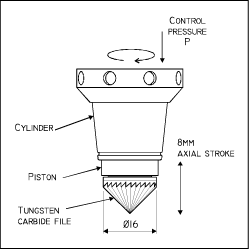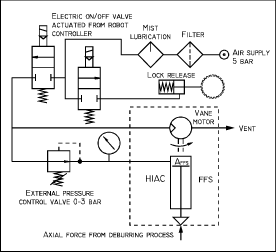Multi-Position Hiac Operation/Specifications

The FFP or Free Flying Piston,
is an important part of the Hiac.
The FFP is pushed
forward into contact with the burr edge by use of a remotely controlled air
pressure. The air vane motor is decoupled from the linear movement of the
FFP, to reduce inertia and increase the stability of the contact force when
deburring. The spline coupling transmits torque to the rotary file.
Ball bearings ensure
an even running of the tungsten carbide file. A very little friction torque
is transmitted through the ball bearings to the FFP cylinder, which rotates
slowly inside the stationary outer cylinder. Thus stick-slip or static friction
of the FFP is avoided. The FFP cylinder is in addition precision ground to
ensure very little friction in the axial direction.

The pneumatic connection
diagram for the Hiac is shown to the right.
A special Speedeburr
adapter is available as extra equipment, to enable standard air nipples to
be coupled to the Hiac. Air silencers can be coupled to the exhaust ports
of the adapter, to take away the noise when exhaust air enters the atmosphere.
The drive air to the
vane motor should be mist lubricated by use of conventional pneumatic equipment.
An external pressure
control valve, for example mounted on the industrial robot's upper arm, will
control the axial force on the rotary tungsten carbide file.
The axial force is
adjusted until a chamfer with the correct width is produced, for a given path
speed.
Specifications:
- Motor: Air motor, vane type.
- Speed: Idle 30,000 rpm, operating
18-25,000 rpm.
- Torque: 0.4Nm at lower speeds.
- Power: 250 W at 20,000 rpm.
- Weight total: 0.51kg.
- Weight FFP with file: 50 g.
- Compensation, due to burr inaccuracy:
max. +/-4mm in/out and sideways, recommended to use +/-2 mm.
- Axial force: 1-25 N, by pressure
0-3 bar.
- File surface speed: 7.5-10.5 m/sec
measured at 8mm diam. (halfway between tip and outer rim).
- Air consumption: Appr. 400 I/min.,
5 bar pressure.
- Sound pressure level: 75 dB(A).
- Sound pressure value: 87 dB(C).
- Rotary burrs: (1)90° coned
shape, straight fluting. (2) 90° coned shape, spiraled
fluting.
(3) Flowerburr, end miller with
contact point.
- Other rotary burr/file qualities
on request.
- Special tools: Burr change tool.
Top
/ Return to Multi-Position Hiac page
/ Return to main Speedeburr page
|